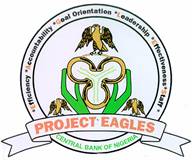Project EAGLES
Project EAGLES overview | Project Impact | IT Initiatives | Project Status Reports: 2006 | Project EAGLES Update
Project EAGLES Update
Over the years, the effectiveness of the CBN and its ability to fulfil its statutory mandate was limited as a result of a blurred focus on its primary regulatory function and the misalignment of the operational and management processes required for the bank to effectively deliver on its responsibilities. The advent of democracy and a deliberate government policy of liberalisation and reforms spurred CBN to embark on a large scale change effort to better enable it fulfil its mandate
Tagged Project EAGLES, the CBN change effort was embarked on to transform the bank into "...one of the most efficient and effective world's Central Banks in promoting and sustaining economic development."
See Frequently Asked Questions on Project EAGLES.
Project EAGLES was designed as a multi-year, multi-phased effort that included:
- Phase I - Diagnostics and Envisioning
- Phase II - Design
- Phase III - Implementation
Project EAGLES Phase I - Diagnostics and Envisioning Phase
The first phase of Project EAGLES was initiated in October 1999. The CBN in partnership with PricewaterhouseCoopers conducted a comprehensive assessment of current operations, identified significant opportunities for improvement and envisioned a fundamentally restructured organisation with substantial changes in the way business is performed.
The aspects of the bank's core and non-core operations that were assessed during this phase included customer service delivery for both internal and external customers, financial/ regulatory oversight function of the CBN, performance management & benchmarking, information technology, customer/ stakeholder satisfaction, human resources and administration and communication effectiveness at all stakeholder levels
This phase of Project EAGLES was concluded in January 2000.
Project EAGLES Phase II - Design Phase
As a follow up to the work done in the first phase of Project EAGLES, Phase II - the Design Phase - commenced in May 2002.
The objective of this phase of the project was to address operational and management issues identified in the Diagnostic phase of the project. This phase was structured along five work streams:
- Communication: This work stream was aimed at institutionalizing
effective communication as a transformation tool aimed at attaining a
widespread understanding of the project and staff buy in at all levels
- Performance Measurement and Improvement: This focused on the
redesign of some operations of the bank with limited IT interventions and the
development of enterprise and process level measures
- Human Resources and Culture Change: This was aimed at ensuring
optimal performance across the bank. In order to achieve this, work done in
this work stream focused on the following:
- Developing HR management systems
- Designing a new staff performance management process
- Designing a new organization structure
- Developing job descriptions for the re-designed process function
- Developing an HR policy and procedure manual
- Conducting a job evaluation and compensation survey
- Information Technology: The IT work stream in phase II focused on
putting in place a technology framework that would support the envisioned
world class efficiency of CBN's operational and management processes. This
resulted in the development of an IT Strategy and the definition of the IT
Organisation Structure and other requirements necessary to support the
strategy.
- Groundwork for the tender and selection process for IT vendors in line
with the new IT strategy was also undertaken in the second phase of Project
EAGLES
- Non-Core Activities: This work stream focused on classifying the entire operations of CBN into three major groups: core, key support and non-core activities. This was aimed at examining ways in which the operations of the bank could be streamlined to ensure that necessary attention and resources are committed to the key functional aspects of the bank's operations
The second phase of Project EAGLES was concluded in February 2002.
Project EAGLES Phase III - Implementation Phase
The third and final phase of Project EAGLES - the Implementation Phase, was embarked on to consolidate on the work done in the prior phases of the project. It commenced in September 2003.
See the "Project Update Links" page for a comprehensive overview of the third phase of Project EAGLES.
Project EAGLES Phase IV - Business Continuity and Integration
Strategy (BCIS)
The Business continuity and Integration Strategy project is part of the
larger organisational wide initiative Project EAGLES. The phase of the
programme is to formulate and articulate specific organisational driven
strategies for specific business orientated focus areas, namely Business
Continuity, Knowledge Management and Service Oriented Architecture.
This phase of the project is the strategic component and will be followed,
given certain strategic insights and required criteria are proven – measured
against the Bank’s strategic intent, by organisational wide implementation
and realisation of the value and benefits of the three specific areas.
Forming part of the strategy articulation phase is a comprehensive element
of skills transfer undertaken within a framework of formal accredited
training and on-the-project in-depth participation and involvement.
The central Bank of Nigeria is assisted and supported on this project by the
international acclaimed solution provider, Atos Origin and by its Nigeria
strategic partner, Global Infoswift.
Business Continuity Management (BCM)
BCM is a business driven process that establishes a fit-for purpose
strategic and operational framework that:
- Proactively improves an organization's resilience against the disruption of its ability to achieve its key objective.
- Provides a rehearsed method of restoring an organisation’s ability to supply its key product and services to an agreed level within an agreed time after a disruption.
- Delivers a proven capability to manage a business disruption and protect the organisation’s reputation and brand.
The Business Continuity Management Programme is an ongoing management and governance process supported by top management and appropriately resourced to ensure that the necessary steps are taken to:
- Ensure continuity of products and services Identify the impact of potential losses
- Maintain viable recovery strategies and plans
- Maintain alignment with CBN processes through training, exercising, maintenance and review
The BCM initiative at the Central Bank of Nigeria entails:
- Understanding of the Bank:
- Objectives, Obligations, Statutory Duties, Drivers
Activities, Assets, Resources (both internal and external)
- Objectives, Obligations, Statutory Duties, Drivers
- Identifying the Perceived Threats to the business
- Understanding the Impact and Consequences over time, if those threats are realized
- Designing a Business driven strategy that will be the context for a Business Continuity Plan (BCP) that provides a planned and tested response to disruption
- Installing a mechanism to ensure the continuing relevance of the BCP
Knowledge Management (KM)
Knowledge Management is a methodology to manage the corporate knowledge asset. The key determinants in the KM drive include channeling the right knowledge, to the right people, at the right time.
The KM initiative aims at retaining and sharing the core corporate knowledge that will realise CBN’s vision to be a leading Central Bank in the world. It will be the catalyst in transforming the Bank into a Learning Organization.
KM Drivers are those aspects of the organisation that really make KM important within the organisation. For the Bank, these are:
-
CBN Mandate, Vision and Strategy
- FSS 2020
- Autonomy and Management Decision Making
- Corporate Governance and Compliance
- Corporate Culture and Values
- Strategic Alliances and Stakeholders
- Learning Environment and Skill Retention
- Business Continuity Management (BCM)
- Global Trends
- Knowledge Sharing Platform
- Enhanced Skills
- Performance Improvement
- Business Continuity
- Culture Change Support
Knowledge Management will also impact on Learning and Performance through:
- Establishment of a unified and integrated KM portal, linking the
instance of knowledge, sources of knowledge and users of knowledge
together
Invariably, Knowledge Management will create an environment of:
- Knowledge Sharing
- Learning
- Enhanced Corporate Memory
Service Oriented Architectures (SOA)
Service Oriented Architecture (SOA) is a powerful enterprise wide architectural approach through which systems functionality is exposed as a hierarchy of services via interoperable technologies.
Service Oriented Architecture is a platform to develop a strategy for integrating the enterprise Business Applications installed and operational in an organization to ensure a secure and seamless flow of information across the various applications based on the defined business process and workflow of the organization. There is a continuous drive to automate, optimize, and integrate business processes within the business and outside across the extended enterprise. To meet new mandates, initiatives, compliance, and regulations that are forced upon them, organizations are focusing on their core business processes, optimizing the way they do business to take advantage of their core strengths and strategies. There is now a strong desire among IT executives to use business process-focused integration approaches rather than point-to-point ad-hoc integration using proprietary methods. Business transparency and agility enable organizations to adapt and react to changing and more competitive markets
The Service Oriented Architecture vision statement of the Central Bank of Nigeria is:
“To be one of the most agile central banks in the world with secure, optimised business process services and technology integration that delivers world class services”
The Business Drivers for SOA are as follows:
- The Central Bank of Nigeria’s Vision & Statutory Mandate
- Valid Business Processes to deliver and end-to-end business value
chain.
- An Agile IT Environment.
- Establish an appropriate IT structure and budget, and to extract
maximum value from the IT investment
The following business objectives have been identified for the Service Orientated Architecture work stream:
- Streamlining and integrating the Banks business processes.
To limit the proliferation of point-to-point integration to reduce complexity and effectively manage the interaction between the various business applications and processes. It will also ensure smooth workflow across the processes that are currently fragmented across the various business application systems, by focusing on legacy system reuse. - Optimising the IT Architecture for effectiveness and efficiency
To minimise transaction processing overheads since the transactions are currently supported through a complex networks of interfaces across different applications. It will also ensure that cross-application business events are visible to those that can react and respond to them. - Integrating world class technology with business process
To ensure the integration is designed with full consideration of the capabilities of current technologies, business applications installed in the Bank and the Business Continuity Management Strategy of the Central Bank of Nigeria - Develop a framework for new technologies and applications
To develop a road map for the cost-effective integration of the business applications of the Central Bank of Nigeria to enable seamless workflow


 Flickr
Flickr Instagram
Instagram LinkedIn
LinkedIn